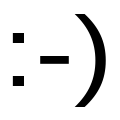| Icon | Emoji | Meaning |
|---|
| (>_<)(>_<)>(>w<) | 😣😖 | Troubled [56] [57] |
| (';') | 👶 | Baby [56] |
(^^ゞ(^_^;)(-_-;)(~_~;)
(・.・;)(・_・;)(・・;)
^^;^_^;(#^.^#)(^^;) | 😅😳😓😥 | Nervous, embarrassed, [56] troubled, shy, [57] sweat drop [7] |
| (⁄ ⁄•⁄ω⁄•⁄ ⁄) | 😳 | Embarrassed, flushed [53] |
| (^.^)y-.o○(-.-)y-°°° | 🚬 | Smoking [56] |
| (-_-)zzz | 😴💤 | Sleeping [56] |
| (^_-)(^_-)-☆ | 😉😜 | Wink [56] |
((+_+))(+o+)(°°)(°-°)
(°.°)(°_°)(°_°>)(°レ°) | 😕😶😵🙄 | Confused [56] |
| (o|o) | | Ultraman [56] |
| <(`^´)> | | — [56] |
^_^(°o°)(^_^)/(^O^)/(^o^)/(^^)/
(≧∇≦)/(/◕ヮ◕)/(^o^)丿∩(·ω·)∩(·ω·)^ω^ | 😀😅😆😃😄🙌 | Joyful [56] [57] [58] |
(__)_(._.)__(_^_)_<(_ _)>
<m(__)m>m(__)mm(_ _)m | 🙇 | Kowtow as a sign of respect, or dogeza for apology [56] [57] |
| (凸ಠ益ಠ)凸 | 🖕 | Middle fingers [53] |
| \(°ロ\)(/ロ°)/ | 🤔 | Questioning [56] |
('_')(/_;)(T_T)(;_;(;_;)(;_:)(:_;)(;O;)(ToT)(T▽T)
;_;;-;;n;;;
Q.QT.TTnTQQQ_Q | 😭😢 | Sad, crying [17] [56] [57] [53] |
| (ー_ー)!!(-.-)(-_-)(一一)(;一_一) | 😒😩😑😞😔 | Shame [56] |
| (=_=) | 😫😩😪 | Tired [56] |
| (=^・^=)(=^・・^=)=^_^= | 😺😸😹😻😼😽🙀😿😾🐱 | Cat [56] [58] |
| (..)(._.) | 🙍😔 | Looking down [56] in sadness or boredom |
| ^m^ | 🤭 | Giggling with hand covering mouth [56] |
| (・・?(?_?) | 😕😵 | Confusion [56] |
| (-‸ლ) | 🤦 | Facepalm [59] |
>^_^<<^!^>^/^(*^_^*)§^.^§(^<^)
(^.^)(^ム^)(^·^)(^.^)(^_^.)(^_^)(^^)
(^J^)(*^.^*)^_^(#^.^#)(^—^) | 😃😄☺️😁😀😍 | Normal laugh [56] |
(^^)/~~~(^_^)/~(;_;)/~~~(^.^)/~~~(-_-)/~~~
($··)/~~~(@^^)/~~~(T_T)/~~~(ToT)/~~~ | 👋 | Waving [56] |
\(~o~)/\(^o^)/\(-o-)/
ヽ(^。^)ノヽ(^o^)丿(*^0^*) | 😍😀🙌💃 | Excited [56] |
(*_*)(*_*;(+_+)
(@_@)(@_@。(@_@;)\(◎o◎)/! | 😍 | Amazed [56] |
| !(^^)! | | — [56] |
(*^^)v(^^)v(^_^)v(’-’*)
(^v^)(^▽^)(・∀・)(´∀`)(⌒▽⌒) | 😂✌️ | Laughing, cheerful [56] [57] |
| \(^o^)/\(^o^)/ | | Hopeless [60] [61] |
| (~o~)(~_~) | 😔😒😏 | — [56] |
| (^^ゞ | 😙😚 | — [56] |
| ˊ_>ˋ | | Calmness [62] |
| (p_-)(-_q) | 🧐 | — [56] |
| ((d[-_-]b)) | 🎧 | Headphones, listening to music [56] |
(-"-)(ーー゛)(^_^メ)(-_-メ)(~_~メ)(--〆)
(・へ・)(`´)<`~´><`ヘ´>(ーー;) | 😟😓😬 | Worried [56] [57] |
| (^0_0^) | 🤓😎 | Eyeglasses [56] |
| ( ..)φφ(..) | ✍️📝 | Jotting note [56] |
(●^o^●)(^v^)(^u^)(^◇^)
( ^)o(^ )(^O^)(^o^)(^○^))^o^(
(*^▽^*)(✿◠‿◠) | 😀😁😆😅😃😄 | Happy [56] [57] |
| ( ̄ー ̄) | 😁 | Grinning [57] |
| ( ̄□ ̄;)°o°°O°:Oo_Oo_0o.O(o.o)oO | 😲😮😯 | Surprised [2] [57] |
| (*´▽`*)(*°∀°)=3 | | Infatuation [57] |
| ᕕ( ᐛ )ᕗ | 💃🕺 | Dancing, swinging arms back and forth, "Happy Gary" [63] |
| ( ゚ Д゚)(°◇°) | 😨😱😮😲 | Shocked, surprised [57] |
| (* ̄m ̄) | 😬😠😡 | Dissatisfied [57] |
| ヽ(´ー`)┌¯\_(ツ)_/¯¯\(°_o)/¯ | 🤷 | Mellow, shrug [57] [64] |
| (´・ω・`)(‘A`) | | Snubbed or deflated [57] |
| (づ ̄ ³ ̄)づ | 🫂😙 | Hugging/reaching and kissing [53] |
| (*^3^)/~☆ | 😘😚😙😗 | Blowing a kiss [65] |
| .....φ(・∀・*) | | Studying [65] |
| (-_-) zzz(︶。︶✽) | 😴💤 | Sleeping [66] |
| uwu UwU | 😌 | Joy [67] or Cute [68] |
| OWOOwO | | Associated with the response, "what's this?". [68] Could also be used to denote cute, inquisitive or perplexed, sometimes associated with the furry fandom. [69] |
| 囧 | 😩😫 | Distress. [70] Jiong, a Chinese character meaning a "patterned window", now repurposed as an ideographic emoticon. |
